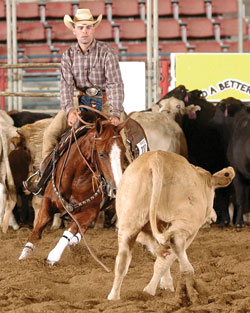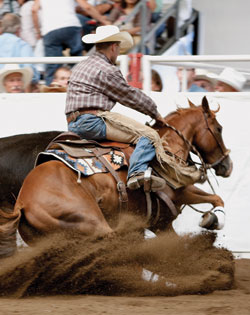 |
| Dale checks the cattle custom grazing on Justabouta Ranch. He is riding One Smart Kid, a half-sister to Another Smart Kid who has earnings over $40,000. Photo by Judy Wood/judywoodartphotography.com |
Working Cow Horse Tips from the Pros
To be successful in the working cow horse arena takes a lot of hard work and dedication. For Dale Clearwater of Justaboutaranch near Hanley (southwest of Saskatoon), his success comes from a program designed after many years in the saddle as a working cowboy and competitor.
First, you have to start with a good product. You can’t make a silk purse out of a sow’s ear. The working cow horse event is very demanding as the horse has to have the athletic ability and trainability in three different events: herd work, reined work and fence work. If your horse doesn’t have superior athletic ability, you may have a long road ahead of you.
Also, invest in a broke horse when you are first starting. It is really hard to take a green horse and a green rider and put them together. If you have a green rider and a broke horse, the horse will teach you a lot of what you need to know, you will avoid a lot of frustration and have a lot more fun.
Building a qualified, professional maintenance team to support your equine athlete from its hooves to its teeth is very important. Find people whom you trust and do a good job.
Exercise and consistent riding is essential. Because the cow horse event is so physically demanding, they need to be in really good physical shape. If they are not in shape you begin to run into lameness problems and once you start down that road it can be a long road to recovery so prevention is the key.
I work hard to ensure that the horses get ridden five days a week. During a typical ride, I work on reined work, walking, trotting and loping to warm the horse up. Then I either do cow work cow work (by working either a mechanical flag, buffalo, or cow) or more reined work, such as stopping and turn-arounds.
 |
| Dale competes in the herd work portion on Lil War Bonnet at the NRCHA Snaffle Bit Futurity in Reno, Nevada, 2009 Photo by Primo Morales Photography/primopictures.com |
After the workout, I cool them out by walking around with a loose saddle. If a horse has a few days off, I take a few days to leg them up again before going back to cow work or harder reined work elements — especially horses that are really athletic. If they are not in shape and you put them in front of a cow, or stop them hard, you may hurt them.
Keeping a show horse’s mind sound is another priority. If you ride strictly in the arena and are training on them, you are going to end up with a horse that begins to not enjoy their job very much. Swishing tails and pinny ears are not desirable traits and I try to prevent them. One good way is to give horses a job change every now and then. Whether it’s out doing pasture work, checking yearlings and doctoring, dragging calves to the branding fire or even simply going for a ride down the road or loping circles in the field rather than the arena — it gives the horse a break. Then, when you bring them back to the arena, typically they are more willing to try.
To be successful in the arena I also believe that practice makes perfect. The more show experience you can get, the better. When you first start, putting together a run can be intimidating but the more you practice, the easier it gets and you learn to react as the run unfolds. Do your research; find a local cow horse association and go to the weekend shows. The entry fees are affordable and it’s a great place to build skills.
Learning to read and work cattle is also an important part of putting together a good cow horse run. I recommend taking clinics or riding with an experienced cowboy who can teach you how to read cattle. The more “cow sense” you have as a rider the better. When it comes to showing, cow sense and timing are everything.
The best advice I can offer is this; be willing to try anything. When you go to clinics or take lessons or even just ask for advice, listen to what they have to say and humble yourself enough to try it, even if it is only once. Take the best parts of peoples programs, work them into your own and throw out the rest. If you find a program that you really like, use that person as a mentor and ask questions. More times than not, trainers are more than willing to share what they know if you ask, but they are a lot less likely to just come over and tell you to try something different.
 |
| The dirt was flying with this fence turn for Dale on Bobby Jo Rooster at the Calgary Stampede Working Cow Horse show in 2009. The duo finished Co-Reserve Champion. Photo by Primo Morales Photography/primopictures.com |
Dale Clearwater’s Top 10 Working Cow Horse Tips
1. Start with a good horse
2. Learn to read cattle
3. Take clinics and / or lessons
4. Ask questions
5. Keep your horse in good physical shape with exercise as well as proper nutrition
6. Ensure proper warm up and cool down when riding
7. Build a great maintenance team
8. Practise, practise, practise
9. Keep your horse’s mind sound by varying his work
10. Have fun!
Dale Clearwater, his wife Teri and their sons Caleb and Westin, own and operate Justaboutaranch near Hanley, Sask. Dale is a multi-champion in the fields of working cowhorse, snaffle bit, hackamore, cutting and ranch horse competitions. For more on Dale, visit their website at: www.justaboutaranch.com













